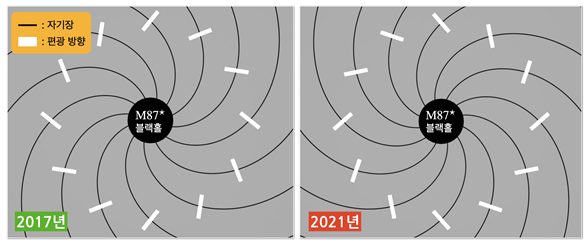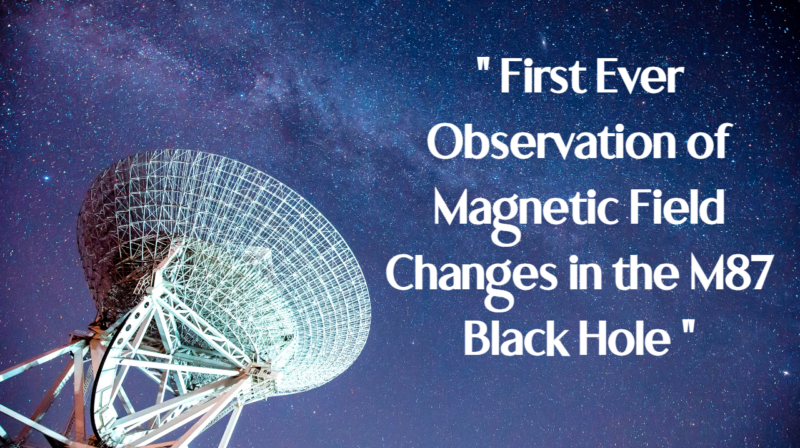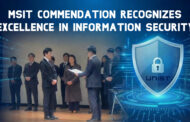Professor Jae-Young Kim of the Department of Physics at UNIST, in collaboration with an international team of researchers, has unveiled a groundbreaking new image of the supermassive black hole at the center of galaxy M87, known as M87*. The Event Horizon Telescope (EHT) collaboration announced on September 16 that, after four years of meticulous observations since 2017, they have detected a reversal in the magnetic field pattern surrounding M87*. This marks a significant advancement in understanding black hole environments.
***Understanding the EHT
The Event Horizon Telescope (EHT) is a global network of radio telescopes functioning as a unified, Earth-sized observatory. Its mission is to capture the most detailed images of black holes, testing Einstein’s theory of general relativity and exploring the extreme physics near event horizons.
 Figure 1. Images of M87*, captured by the EHT collaboration. The latest observations, based on data collected in 2021, constitute the third direct imaging of M87*, following the landmark 2019 photograoh—the first-ever image of a black hole’s shadow—and the subsequent 2018 image. While the size and shape of the black hole’s shadow remained consistent over the years, the polarization patterns—indicative of magnetic field orientations—exhibited striking changes. l Image Credit: ©EHT Collaboration
Figure 1. Images of M87*, captured by the EHT collaboration. The latest observations, based on data collected in 2021, constitute the third direct imaging of M87*, following the landmark 2019 photograoh—the first-ever image of a black hole’s shadow—and the subsequent 2018 image. While the size and shape of the black hole’s shadow remained consistent over the years, the polarization patterns—indicative of magnetic field orientations—exhibited striking changes. l Image Credit: ©EHT Collaboration
Compared to 2017, the polarization direction in 2021 was reversed, indicating a profound reorganization of the magnetic fields near the event horizon. Researchers suggest these shifts may result from complex plasma interactions and the influence of a phenomenon known as the Faraday Screen, pointing to a more turbulent and dynamic environment than previously understood.
 Figure 2. A schematic illustrating the evolution of magnetic field lines near M87*. The polarization pattern, initially spiraling in one direction in 2017 (left), reversed in 2021 (right). This evolution underscores the highly active and intricate nature of the black hole’s immediate surroundings. l Image Credit: ©EHT Collaboration
Figure 2. A schematic illustrating the evolution of magnetic field lines near M87*. The polarization pattern, initially spiraling in one direction in 2017 (left), reversed in 2021 (right). This evolution underscores the highly active and intricate nature of the black hole’s immediate surroundings. l Image Credit: ©EHT Collaboration
Professor Kim played a vital role in orchestrating these observations, securing critical telescope time—including for the Atacama Large Millimeter/submillimeter Array (ALMA)—and actively participating in data analysis. His leadership facilitated Korea’s integration into this international effort. Notably, his graduate student Deok-Hyeong Lee led the rigorous verification of the 2021 data, marking a significant achievement for Korea’s scientific community.
Esteemed astrophysicists such as Dr. Paul Tiede of the Harvard & Smithsonian Center for Astrophysics and Dr. Mikhail Janssen of Radboud University in the Netherlands emphasized the importance of these findings. Dr. Tiede highlighted how long-term imaging deepens our understanding of the extreme environments around black holes, while Dr. Janssen noted that the results challenge existing models and reveal unexpectedly complex magnetic structures.
Professor Kim explains, “Near the event horizon, hot plasma rapidly accretes onto or is expelled from the black hole, stirring the surrounding environment and causing observable changes in polarization.” He added, “Achieving a full understanding of these phenomena will require even more refined models and observations.”
Korea’s contributions have been instrumental. Professor Kim and Deok-Hyeong Lee enhanced imaging algorithms and provided critical insights into magnetic field dynamics. In particular, the direct involvement of a graduate student in verifying key data exemplifies Korea’s commitment to cultivating the next generation of astrophysicists.
The EHT team plans to expand its observational campaigns, aiming to produce real-time, dynamic videos of black hole activity. In 2026, they intend to capture the first-ever movie of a black hole’s behavior, with Korea’s Korean VLBI Network (KVN) actively participating to improve imaging precision.
Professor Kim also serves on the EHT Scientific Committee, guiding the long-term scientific vision. He states, “The EHT is rapidly evolving—upgrading telescopes, developing new algorithms, and expanding observation networks. Our goal is to connect space-based, lunar, and ground observatories to image even more distant and enigmatic black holes.”
These groundbreaking findings are published in the September 2025 issue of Astronomy & Astrophysics. The research involved collaborations with Kyung Hee University, the Korea Astronomy and Space Science Institute, and Yonsei University.















